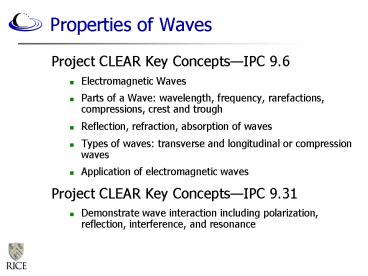Properties of Waves - PowerPoint PPT Presentation
1 / 16
Title:
Properties of Waves
Description:
Parts of a Wave: wavelength, frequency, rarefactions, compressions, crest and trough. Reflection, ... http://www.falstad.com/ripple/ 2) Start with 'Setup: Basic. ... – PowerPoint PPT presentation
Number of Views:1586
Avg rating:3.0/5.0
Title: Properties of Waves
1
Properties of Waves
- Project CLEAR Key ConceptsIPC 9.6
- Electromagnetic Waves
- Parts of a Wave wavelength, frequency,
rarefactions, compressions, crest and trough - Reflection, refraction, absorption of waves
- Types of waves transverse and longitudinal or
compression waves - Application of electromagnetic waves
- Project CLEAR Key ConceptsIPC 9.31
- Demonstrate wave interaction including
polarization, reflection, interference, and
resonance
2
Waves
- Definition
- What is a wave?
- Examples
- Name several types of waves.
- Definition
- Mechanical
- Electromagnetic
3
Transverse and Longitudinal
http//www.physicsclassroom.com/Class/waves/U10L1a
.html
http//www.physicsclassroom.com/Class/waves/U10L1a
.html
4
ConcepTest
The graph shows the displacement, s, of a slinky
as a function of position, x, along the slinky.
The wave is
- a transverse wave
- a longitudinal wave
- either of the above
- none of the above
5
Wavelength, Amplitude
http//www.onr.navy.mil/focus/ocean/motion/waves1.
htm
6
Interference
7
Diffraction
- A change in direction of a wave as it passes
though an opening or around a barrier - Diffraction can be used to determine the atomic
and molecular structure of crystalline solids.
http//www.matter.org.uk/diffraction/introduction/
what_is_diffraction.htm http//micro.magnet.fsu.ed
u/primer/java/diffraction/basicdiffraction/index.h
tml
8
Using Diffraction Patterns to Determine Structure
http//micro.magnet.fsu.edu/optics/lightandcolor/d
iffraction.html
9
Diffraction Conditions
Bragg diffraction
q
d
q
q
d
For constructive
interference,
d
n
2(
sin
)
l
q
10
Discovery Slide
11
Line Diffraction
12
Diffraction by Square Unit Cells
13
Refraction of Light
- What is the speed of light?
- Light moves through materials at different
speeds.
Refractive Index
14
Refraction of Light
- When light hits the boundary between two
materials of different n, the light gets
refracted (appears to bend). - The angle of refraction depends on
- Angle of incidence
- Refractive index of materials
- Which has the greater value of n?
- Glass
- Water
http//micro.magnet.fsu.edu/primer/lightandcolor/i
ndex.html
15
n Values of Common Materials
16
Websites on Waves
- Reading
- http//www.physicsclassroom.com/Class/waves/wavest
oc.html - http//www.colorado.edu/physics/2000/schroedinger/
index.html (and following) - Explorations
- http//www.surendranath.org/Applets.html
- http//www.phy.ntnu.edu.tw/java/waveType/waveType.
html - http//www.netzmedien.de/software/download/java/in
terferenz/index.html - Problems
- http//www.explorelearning.com/index.cfm?methodcR
esource.dspViewResourceID48CFID729720CFTOKEN
30846136 (requires shockwave and sound) - 1) What are the unknown frequencies? How did you
determine this? - http//www.falstad.com/ripple/
- 2) Start with Setup Basic. Adjust simulation
speed, resolution, damping, frequency, and
brightness until you have a feeling for what they
all do. What kind of wave is shown (standing,
traveling, etc.)? Click Add Border. What kind
of wave is shown? Why? - 3) Change the setup to Double Slit. Describe in
words the effect you observe and its origins. - 4) Change the setup to Beats. Notice the
pattern of dark bands. What is the origin of this
effect? What parameter can you adjust to modify
it, or even remove it? Why does that parameter
allow you to do this? - Observe slow medium, refraction, internal
reflection, and scattering. (No problems
associated with these.)































